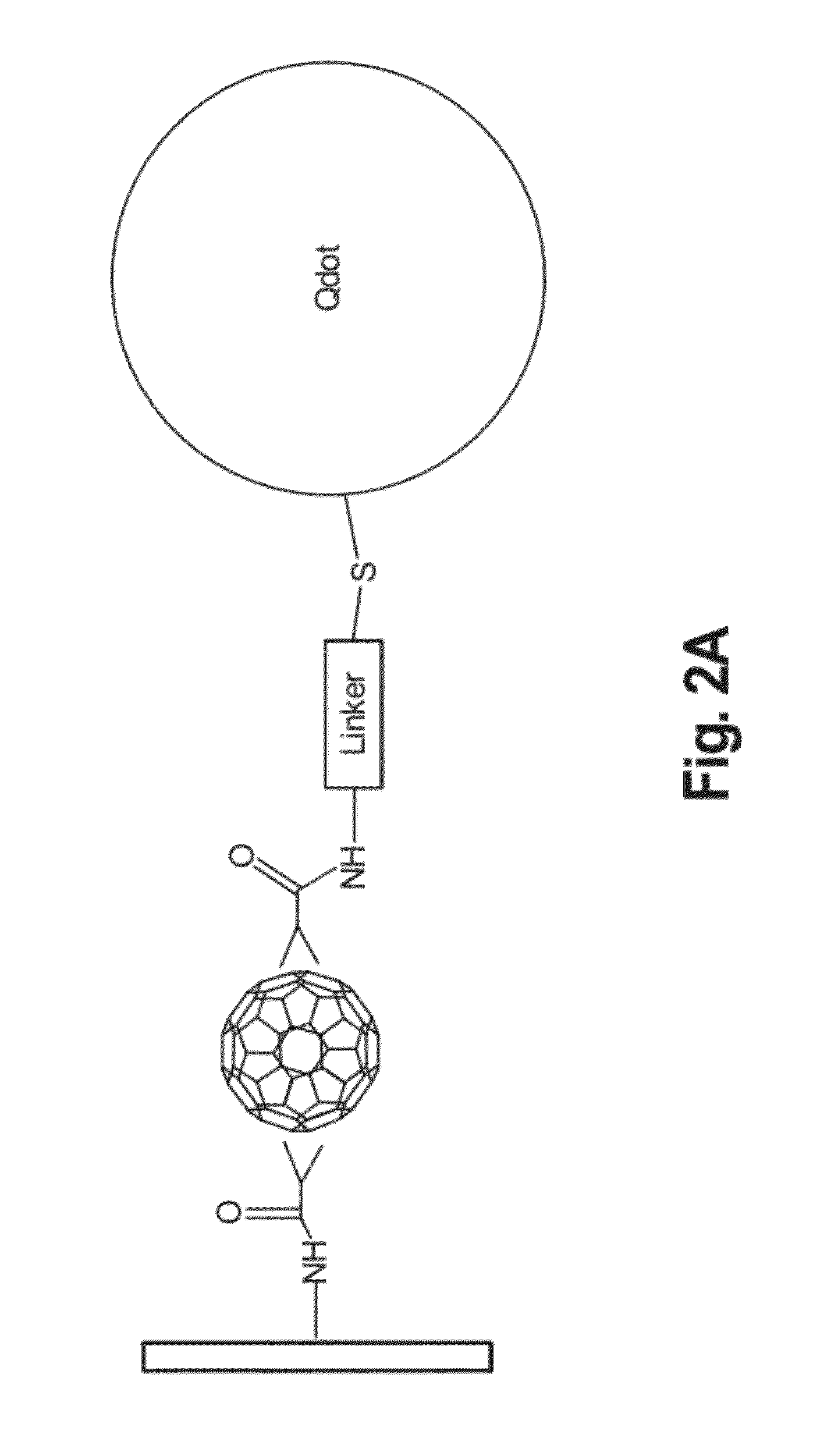Stepwise Surface Assembly of Quantum Dot-Fullerene Heterodimers
- Summary
- Abstract
- Description
- Claims
- Application Information
AI Technical Summary
Benefits of technology
Problems solved by technology
Method used
Image
Examples
example 1
[0065]Single molecule fluorescence measurements were conducted with a custom-built confocal scanning microscope based on inverted Olympus IX81 coupled with pulse laser excitation. 920-nm infrared laser output was provided by a mode-locked Ti:Sapphire femtosecond laser (Tsunami 3960, Spectra-Physics) pumped by 10-W diode laser (Millennia Pro, SpectraPhysics) and was passed through a frequency doubler and pulse picker to generate a 460-nm laser beam with 8 MHZ repetition rate. The laser beam was then reflected by a dichroic filter (Di01-R442, Semrock) and focused on the sample surface with a 100×1.4 NA oil immersion objective (Olympus). Fluorescence from the sample was passed through the same objective and the dichroic filter, and was filtered by a 75-μm pinhole and a bandpass filter (FF01-583 / 120, Semrock) before it was collected by an avalanche photodiode (APD). Time-correlated single photon counting unit PicoHarp 300 (PicoQuant) was used for the data acquisition with time-tagged ti...
example 2
[0068]A stepwise surface-based assembly procedure was designed that yields Qdot-FMH dimers of high purity (see FIG. 3) and includes the following: (1) glass cleaning, (2) surface silanization, (3) fullerene malonic acid hexadduct (FMH) immobilization, (4) linker bonding, and (5) quantum dot conjugation.
[0069]In detail, glass slides (25×25 mm) were first cleaned by soaking in Piranha solution, made of 30% (v / v) Hydrogen Peroxide (Sigma Aldrich, St. Louis, Mo.) and 70% (v / v) Sulfuric Acid (Sigma Aldrich, St. Louis, Mo.), for 15 minutes and then thoroughly rinsed by deionized water, e.g., Milli-Q water. After drying by nitrogen gas, the cleaned glass slides were placed in a Petri dish with 20 μl 3-Aminopropyltrimethoxysilane (APTMS) (Sigma Aldrich, St. Louis, Mo.) and the dish was then covered and kept in a desiccator under a vacuum of 20 KPa for 15-120 minutes, followed by heat treatment in an oven (90° C.) for 1 hour. The amine-modified glass slides were then covered by 100 μl mixed ...
example 3
[0071]FIG. 9 demonstrates how the use of the quantum dot-linker-fullerene dimer conjugate structure allows control of the electron transfer properties, both the magnitude of the rate and of rate fluctuation. FIGS. 9A-9D are PL lifetime histograms measured from individual quantum dots (a), individual quantum dot QD605-linker-fullerene dimeric conjugates with linker 16AHT (b), 11AUT (c), and 6AHT (d), and from individual QD605 spincoated on a layer of fullerenes without using linkers (e). For QD605 isomers, the lifetimes distribute symmetrically around 20 ns (standard deviation, σ˜6.5 ns). For QD605-FMH dimers, the lifetime histograms are asymmetric and with peak values diminished to 5 ns (σ˜6.7 ns) for QD605-16AHT-FMH, 3 ns (σ˜5.9 ns) for QD605-11AUT-FMH, and 1 ns (σ˜4.4 ns) for QD605-6AHT-FMH, indicating enhanced electron transfer by reducing linker length as well as fluctuations in electron transfer rate. As a comparison, the PL lifetime histogram of individual QD605 spincoated on ...
PUM
 Login to View More
Login to View More Abstract
Description
Claims
Application Information
 Login to View More
Login to View More - R&D
- Intellectual Property
- Life Sciences
- Materials
- Tech Scout
- Unparalleled Data Quality
- Higher Quality Content
- 60% Fewer Hallucinations
Browse by: Latest US Patents, China's latest patents, Technical Efficacy Thesaurus, Application Domain, Technology Topic, Popular Technical Reports.
© 2025 PatSnap. All rights reserved.Legal|Privacy policy|Modern Slavery Act Transparency Statement|Sitemap|About US| Contact US: help@patsnap.com



